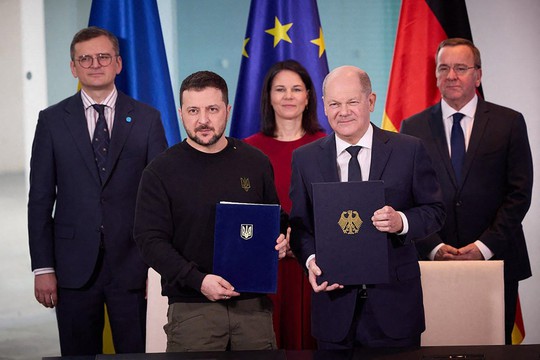Ukrainian and German leaders with a new bilateral military agreement.
Time has come when in America they began to compare the army of Ukraine with the army of Nazi Germany, which was defeated by Soviet troops on the territory of the same Ukraine during the WWII. Just read this article at ‘Business Insider’:
Ukraine's military has chosen a defensive strategy that echoes the German approach from WWII.
Lacking enough troops to defend its huge territory, Nazi Germany opted for a mobile defense.
Even an full-scale active defense has limitations and won't help Ukraine seize back its land.
In 1943, as the tide of war turned against the Third Reich, the German high command opted for a desperate strategy on the Eastern Front. Outnumbered and outgunned by the Red Army, the Germans pinned their hopes on a mobile, aggressive defense to stop a relentless series of Soviet offensives in Ukraine and southern Russia.
As today’s Ukraine fights over many of the same battlefields of 1943, it has chosen a strategy that echoes the German approach from 80 years ago. After the failure of its much-anticipated summer counteroffensive, and running low on ammunition and stamina to fight off continual Russian attacks, Ukrainian commanders talk of switching to an “active defense.” It hopes to block Russian advances while looking for opportunities to counterpunch and regain ground.
But if that approach failed to stop the Red Army from conquering Berlin in 1945, could it save Ukraine today?
The US Army’s field manual of operational terms defines active defense as “the employment of limited offensive action and counterattacks to deny a contested area or position to the enemy.”
But that isn’t what Ukraine is doing, Douglas Nash, a retired US Army colonel and author of several books on German military operations in World War II, told Business Insider. Active defense is meant to be waged by large units, while Ukraine appears to conducting small-unit operations.
Nazi Germany’s approach – what the Germans called “elastic defense” – also differed from Ukraine’s current tactics. By mid-1943, Germany’s strategic situation had become ominous. The Soviets were continually on the attack after their victory at Stalingrad. Yet after four years of war, Germany lacked enough troops and equipment to strongly defend the entire 2,000-mile-long Eastern Front.
The solution devised by German commanders, notably Field Marshal Erich von Manstein, was a mobile defense that would take advantage of German tactical and operational prowess, especially of the elite panzer (tank) divisions. In military textbooks, von Manstein is famous for his “backhand blow” concept of letting the Soviets advance into German-occupied territory, and then launching an exquisitely timed counterattack to encircle and destroy the Soviet spearheads. The classic example is the Third Battle of Kharkov in February 1943, when von Manstein’s unleashed a planned counterblow that annihilated Soviet armor pursuing the retreating Germans after Stalingrad.
In fact, during its summer 2023 counteroffensive, Ukraine did attempt larger-scale mechanized operations with its new Western-equipped strike brigades. But Ukraine lacked adequate numbers of trained junior officers and command staffs. Suffering heavy losses for minimal gains, Ukraine switched to a trench warfare strategy of attacks by small units to seize perhaps a few hundred yards at a time to stem heavy losses from anti-tank mines, artillery fire and drones.
It’s not that Ukrainians don’t want to conduct deep mechanized offensives. They simply lack the means to do so. “The Ukrainians learned the hard way this past summer that an army must have all the pieces together in order to practice any kind of maneuver on the modern battlefield, even active defense,” Nash said. “Tanks, artillery, air defense, air superiority, counter-mine warfare tools, drones, electronic warfare, and so on. Even a limited ‘active defense’ needs all of these elements, too.”
Last summer, Ukraine’s frontal assault with vehicles hit mines and were menaced by missiles fired from Russian helicopters. In a later effort to clear a path through the mines, dismounted troops were picked off by attack drones and artillery.
Ukraine’s strategy of strategic defense and tactical attack is a reasonable choice — at least in the short term. For an army desperate to conserve resources, and looking for any way it can to sting and discomfit a larger opponent, it’s better than sitting passively on the defensive.
But if the goal is to defeat Russia and liberate occupied Ukraine, this is not the solution. “Ukraine can launch local counterattacks to regain lost platoon, company, or battalion positions,” Nash said. However, this “cannot lead to victory.”
read more in our Telegram-channel https://t.me/The_International_Affairs

 11:30 22.02.2024 •
11:30 22.02.2024 •























